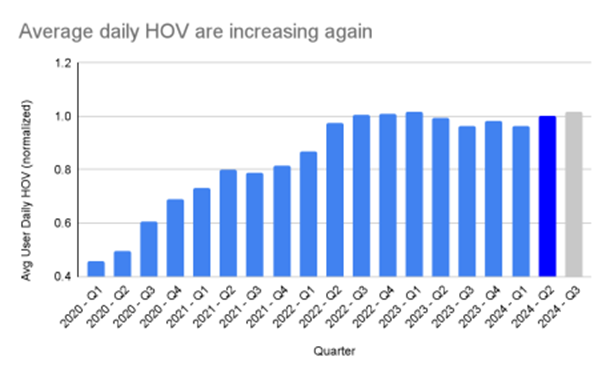A new study of viewing on connected TVs finds a number of encouraging trends, including the fact that viewing levels are approaching the record levels seen during the pandemic and that the average viewing sessions are growing.
But the study also highlighted a number of ongoing examples of viewing dissatisfaction, including relatively stable levels of churn, which have remained persistently high. It also noted that ad loads remain near record levels even though they have dropped slightly from their peak in 2023. In addition, the study provided a ranking of the most common programming genres on TV, with reality TV on top of the list as the most widely distributed content even though reality TV shows rarely rank in the top 10 streaming shows in terms of viewing.
 Source: Wurl
Source: WurlWurl’s study did not provide actual figures for time spent viewing, churn and the average streaming session. Instead it provides an index that shows trends up or down.
The study did report that on average, an ad break in CTV is approximately two minutes long and typically includes four 30-second commercials. Across an entire hour, viewers are exposed to around nine minutes of advertising content on FAST (Free Ad-Supported Streaming TV) channels, which is generally much lower than the ad loads on cable TV networks.
This metric is crucial for understanding the balance between content and advertising and its impact on viewer experience, the researchers said. They reported that July 2023 reached the highest average ad load, averaging 9.4 minutes of advertising per hour of viewing, 2.6% higher the previous month, the month with the second highest ad load. Today’s ad load is down 3.4% from peak, suggesting platforms are showing fewer ads, though numbers are increasing again.
The researchers wrote that
“The amount of advertising content per hour directly impacts the viewer experience. Excessive ad load can lead to viewer dissatisfaction and ad fatigue, while a balanced ad load can enhance viewer engagement and content enjoyment. Managing ad load is crucial for maintaining ad effectiveness. An optimal ad load ensures that ads are delivered at a frequency that maximizes their impact without overwhelming viewers. Changes in ad load can influence revenue generation. Increased ad load may boost ad revenue in the short term, but overloading can lead to viewer churn, ultimately affecting long-term revenue and platform profitability.”
The report also found that “approximately 4% of viewers are lost per minute of an ad break, meaning an 8% loss during a typical two-minute break. However, research by Wurl found that emotional resonance between ad and content can reduce user loss by as much as 60%.”
The full report along with detailed recommendations for capitalizing on its findings can be found here.
Soure: tvtechnology.com

